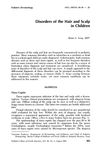Hair Loss in Adult Females: A Clinical and Trichoscopic Study
January 2021
in “
International journal of dermatology, venereology and leprosy sciences
”
female pattern hair loss telogen effluvium pityriasis sicca alopecia areata canities pediculosis capitis scalp psoriasis seborrheic dermatitis trichoscopy empty hair follicles focal atrichia anisotrichosis vellus hair pilosebaceous units eccrine ducts honeycomb pattern female pattern baldness hair shedding dandruff gray hair head lice psoriasis seborrhea hair examination hair follicles hair loss patches uneven hair thickness fine hair hair follicles with oil glands sweat glands skin pattern

TLDR Most adult women experiencing hair loss are aged 21-40, with the most common type being female pattern hair loss. Trichoscopy is a useful tool for diagnosing different types of hair loss.
The study "Hair loss in adult females: A clinical and trichoscopic study" analyzed the patterns of hair loss in women using trichoscopic evaluation. The majority of the patients (67%) were aged between 21-40 years, and the most common symptom was hair fall. A positive hair pull test was observed in 69.2% of cases. The most common diagnosis was female pattern hair loss (36.2%), followed by telogen effluvium, pityriasis sicca, alopecia areata, canities, pediculosis capitis, scalp psoriasis, and seborrheic dermatitis. Trichoscopy, which revealed features like empty hair follicles, focal atrichia, anisotrichosis, increased vellus hair, pilosebaceous units with 1-2 hair, white dots of eccrine ducts, honeycomb pattern, was found to be an important diagnostic tool, especially when the diagnosis was unclear. It also helped avoid scalp biopsy in difficult cases.


